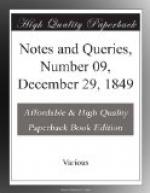On their sunken centres all have religious types: the most common is the temptation of Eve; the next in frequency, the Annunciation; the Spies sent by Joshua returning with an immense bunch of grapes suspended betwixt them, is not unfrequent; but non-scriptural subjects, as the Martyrdom of St. Sebastian, mentioned by L.S.B., is a variety I have not before observed.
The inscriptions vary, and are sometimes double in two concentral rings. The most usual is that alluded to by your correspondents, and though obviously German, neither old nor obsolete; having been viewed even by native decipherers, through the mist of a preconceived hypothesis, have never yet been by them satisfactorily accounted for. It is always repeated four times, evidently from the same slightly curved die; when, however, the enlarged circumference of the circle required more than this fourfold repetition to go round it, the die was set on again for as much of a fifth impression as was necessary: this was seldom more than four or five letters, which, as pleonastic or intercalary, are to be carefully rejected in reading the rest; their introduction has confused many expositors.
The readings of some of your correspondents who understand German is pretty near the truth. {136} I have before said that the centre type of Eve’s Temptation is the most common, and to it the words especially refer, and seem at the place of their manufacture (most probably Nuremburg) to have been used for other centres without any regard to its fitness. The letters, as I can safely aver from some very perfect specimens, are
DER SELEN INFRID WART;
in modern German “der Seelen Infried wort.” To the German scholar the two latter words only require explanation. Infrid for Unfried, discord, disturbance, any thing in opposition to Frieden or peace. The Frid-stools at Beverley, Ripon, and Hexham, still bear the old theotise stamp. Wart, or ward, may be either the past tense of werden, to be (our was), or an old form of waehren, to endure, to last: our English wear is the same word. The sense is pretty much the same in both readings alluding to Eve. In the first:
(By her) the soul’s disturbance came (was).
By the second:
(Through her) the soul’s disturbance continues.
I may here observe that the words ICH WART are particularly distinct on a helmet, pictured in the Journal of the British Archaeological Association, which the Secretary, Mr. Planche, in such matters the highest authority, regards as a tilting helmet. It may there have been in the original ICH WARTE, meaning I bide (my time).




